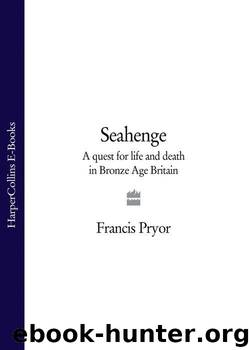Seahenge: a quest for life and death in Bronze Age Britain by Pryor Francis

Author:Pryor, Francis [Pryor, Francis]
Language: eng
Format: azw3
ISBN: 9780007380824
Publisher: HarperCollins Publishers
Published: 2012-06-20T16:00:00+00:00
FIG 15 Plan of Bronze Age fields revealed by air photography at West Deeping, near Maxey. Barrows are shown in bold line
I don’t want to give the impression that barrows, henges and other small, mainly circular, sacred sites were used only in this ostensibly practical way, out in the fields and pastures of the farmed countryside. For a start, the intensively farmed field systems of the Bronze Age are only found in a few places. The vast bulk of the landscape was open grazing, and not necessarily divided up at all. This may apply to the ritual landscape of Maxey ‘island’, where, despite a most careful search, we have so far failed to detect any evidence of ditched and hedged Bronze Age fields. We know from a number of environmental studies that the Bronze Age landscape here was largely open pasture, and cleared of trees – but so far formal fields appear to have been lacking.
Etton went out of use partly no doubt because water levels around it had begun to rise, but partly too because the enclosure had served its purpose and people wanted to do things differently. In particular, they wanted to take control for themselves of those rites and ceremonies they had performed in the eastern family, or private, side of the enclosure. But how could this be done? The enclosure was universally recognised as the main religious and ceremonial centre – and not just by the living. It was inconceivable to consider abandoning it completely – and we know that this did not happen until very much later – but somehow its special powers had to be conducted across the stream channels and onto the main ‘island’.
The means chosen to conduct these special powers was the Maxey Cursus. Cursuses, like henges, are unique to Britain. They consist of two parallel ditches with banks on the inner side, and often have closed ends. The longest in Britain, the Dorset Cursus, currently measures ten kilometres in length. I say ‘currently’ because it regularly becomes extended after a dry summer’s aerial photography. Cursuses were constructed in the Middle Neolithic, at about the same time as or slightly later than causewayed enclosures, and are often found within or close by them.
In general the purpose of cursuses remains obscure, but they sometimes contain burials and are usually found within ritual landscapes. Although attempts have been made to understand them as a group, I find such explanations unsatisfactory. It’s probably best to treat them on a case-by-case basis, as they appear to differ from one ritual landscape to another. Having said that, they undoubtedly played a non-functional, symbolic role, and often one to do with death. We have seen that in Brittany and elsewhere lines of sight played an important part in the way the various components of a ritual landscape fitted together, or articulated. So a minimalist view of cursuses would be that they identified, and made formal, the sight-lines that mattered, very like the careful way people’s thoughts and emotions were channelled five thousand years later at Stowe.
Download
This site does not store any files on its server. We only index and link to content provided by other sites. Please contact the content providers to delete copyright contents if any and email us, we'll remove relevant links or contents immediately.
The Daily Stoic by Holiday Ryan & Hanselman Stephen(3191)
The Fate of Rome: Climate, Disease, and the End of an Empire (The Princeton History of the Ancient World) by Kyle Harper(2973)
People of the Earth: An Introduction to World Prehistory by Dr. Brian Fagan & Nadia Durrani(2672)
Ancient Worlds by Michael Scott(2574)
Babylon's Ark by Lawrence Anthony(2486)
The Daily Stoic by Ryan Holiday & Stephen Hanselman(2420)
Foreign Devils on the Silk Road: The Search for the Lost Treasures of Central Asia by Peter Hopkirk(2403)
India's Ancient Past by R.S. Sharma(2365)
MOSES THE EGYPTIAN by Jan Assmann(2342)
The Complete Dead Sea Scrolls in English (7th Edition) (Penguin Classics) by Geza Vermes(2198)
Lost Technologies of Ancient Egypt by Christopher Dunn(2169)
The Earth Chronicles Handbook by Zecharia Sitchin(2148)
24 Hours in Ancient Rome by Philip Matyszak(2023)
Alexander the Great by Philip Freeman(2008)
Aztec by Gary Jennings(1927)
The Nine Waves of Creation by Carl Johan Calleman(1839)
Curse Tablets and Binding Spells from the Ancient World by Gager John G.;(1816)
Before Atlantis by Frank Joseph(1784)
Earthmare: The Lost Book of Wars by Cergat(1760)
